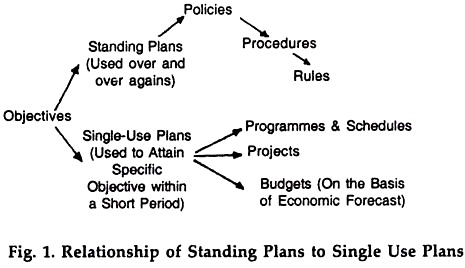This article throws light upon the eight important types of plans. The types are: 1. Objectives 2. Policies 3. Rules 4. Procedure 5. Programme 6. Schedules 7. Budget 8. Forecasting.
Plans: Type # 1. Objectives:
Objectives are plans for the future that will serve to provide direction for subsequent activity. We have a hierarchy of objectives. Primary or basic objectives are determined by the top management. Each department has its own objectives within the framework of basic goals.
Plans: Type # 2. Policies:
A policy is a standing plan or answer to recurring questions. It is a continuing decision which applies to repetitive situations. It is a guide to action or decision of a manager. A policy helps keep work in line with objective.
ADVERTISEMENTS:
Policies are directives providing continuous framework for executive actions on recurrent managerial problems. Policies take the form of general statements to lead managerial activity through proper channel towards the objective. For instance, a firm has a policy of promotion from within.
If a vacancy arises, naturally the first preference is given to existing employees if they meet the job requirements. A policy assists decision making. But deviations may be needed, of course, as exceptions and under some extraordinary circumstances. In other words, there is a limited scope for discretion in dishonouring a policy.
Plans: Type # 3. Rules:
Rules are the simplest type of plan chosen from alternatives. A rule requires that a specific action be taken or not taken with respect to a situation. It is more rigid and more specific than a policy. It guides action but provides no discretion in its strict application.
Of course, rules are essential for discipline and smooth operations of the business. No smoking rule in a factory is applicable to all including the top executives. A rule is designed to define in advance, what alternative must be selected, or what decision must be made. In effect it dictates the way an activity is to be (or is not to be) done. A rule is related to procedure.
Plans: Type # 4. Procedure:
ADVERTISEMENTS:
It is a standing plan acting as a means of implementing a policy. For example the sales department lays down a policy to execute all orders within 48 hours. The procedure of execution of orders will prescribe a sequence of steps that must be followed after the receipt of an order till the dispatch of goods to the customer.
These chronological series of steps or tasks constitute a procedure. A procedure lays down the manner or method by which work is to be performed in a standard and uniform way.
Once a procedure is established, it ensures uniformly high level of performance. It results in work simplification and eliminates overlap or duplication of efforts. Policy guides thinking and action, whereas procedure guides action only to fulfil the objectives.
Plans: Type # 5. Programme:
It is a single use plan. It is a sequence of activities designed to implement policies and accomplish objectives. It gives step-by step approach to guide action necessary to reach predetermined targets. It is an instrument of co-ordination, i. e., a timetable of action. A good programme ensures smooth and efficient operation. A procedure tells how it is to be done, whereas a programme tells what is to be done.
ADVERTISEMENTS:
It enables a manager to prepare carefully and systematically for difficulties, before they arise. We have detailed programmes of personal selling advertising, and sales promotion in our marketing campaign to accomplish the set goals in sales and to reach the particular market.
Plans: Type # 6. Schedules:
Scheduling is the process of establishing time sequence of the work to be done. It is an integral part of programming. A schedule specifies the time when each of a series of actions should take place. Once the tasks to be done and the persons who must do them are clear according to our standing plans, scheduling may be the only element needing immediate management attention.
Plans: Type # 7. Budget:
A budget is a projection (and a plan) defining anticipated costs of attaining an objective. It is an appraisal of expected expense against anticipated income or a future period. It may be stated in time, materials, money or other units required to perform work and secure specified result.
Since most values are denoted in money, we have usually money budgets. E budget is a type of plan. It is also used as a control device. However, the budget begins as a forecast and therefore, requires planning.
ADVERTISEMENTS:
The master budget of the company is a formal expression of plans, objectives and goals prescribed by the top management in advance for the enterprise as a whole. We also have budget for each subdivision of the enterprise. It indicates the amount of money to be spent for…. by each department.
Plans: Type # 8. Forecasting:
We have three types of forecasting:
(a) Extrapolation,
(b) Economic forecasting, and
ADVERTISEMENTS:
(c) Marketing research.
Forecasting is based on statistical data and marketing research. Economic forecasting is the basis of planning. Forecasting is a systematic attempt to probe the future on the basis of known information. Planning decisions are based upon intelligent and rational forecasting the future trend of specified events, e.g., price trend.
